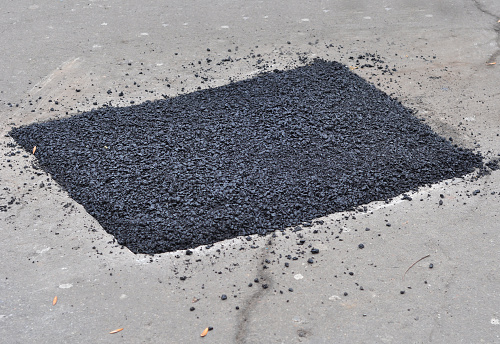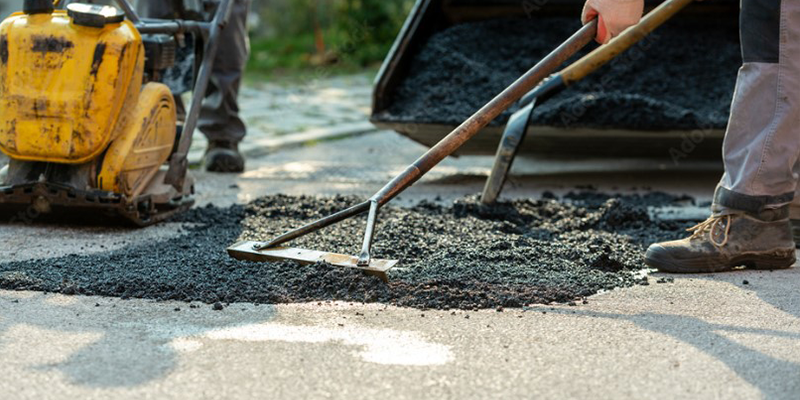When you travel on roads, you might notice some rough spots and holes. That’s where asphalt patching comes in – a superhero technique that makes our roads smoother and safer. In this article, we’ll explore how patching helps fix those troublesome road problems and makes our journeys better.
What is Asphalt Patching?
Imagine you have a favorite shirt with a small tear. You don’t want to throw it away, so you sew up the tear to make it whole again. Asphalt patching is similar. When roads get damaged by potholes, cracks, or other issues, patching steps in to fix those problems. It’s like giving the road a quick sew-up to make it strong and smooth once more.
Patching Up Potholes
Have you ever seen holes in the road that look like puddles but aren’t filled with water? Those are called potholes, and they can make driving bumpy and tricky. Potholes happen when the road’s surface gets damaged by things like rain, traffic, and changes in temperature. Patching is like giving the road a special medicine. Workers fill the potholes with a fresh mix of asphalt, smooth it out, and make the road whole again.
Cracking Down on Cracks
Just like how your skin can get little cracks when it’s dry, roads can get cracks too. These cracks might seem small, but they can grow bigger and cause trouble. When cracks appear, patching is there to help. Workers carefully fill the cracks with special materials that prevent them from getting worse. It’s like putting a bandage on the road to keep it strong.
Why Patching is Important
Patching isn’t just about making roads look nice – it’s about safety too. Bumpy roads and potholes can make driving uncomfortable and even dangerous. They might make cars wobble or even cause accidents. When patching fixes these problems, it’s like giving the road a hug, making it safe and pleasant for everyone who uses it.
Different Patching Techniques
Patching isn’t a one-size-fits-all approach. Just like how different puzzles need different pieces, different road problems need different patching techniques. For small cracks, workers might use a liquid material that fills the gaps. But for bigger holes, they might need to use hot asphalt mix. Each technique is like a superhero with its own power to fix a specific road issue.

A Team Effort
Patching is not a job for just one person. It’s a team effort that involves skilled workers, special tools, and materials. Workers start by cleaning the damaged area, then they apply the patching material carefully. It’s like giving the road a gentle, healing touch. The patch needs time to settle and become strong, so workers might close off the area temporarily to keep everyone safe.
Preventing Problems with Patching
Patching doesn’t just fix problems – it can also prevent them. Regular patching can stop small problems from becoming big ones. It’s like taking care of your teeth by brushing them every day. By fixing cracks and holes early, we help the road stay healthy and avoid bigger repairs later.
Seeing the Results
After patching, the road looks much better. Bumpy areas become smooth, and those annoying potholes disappear. It’s like watching a magic trick that turns a damaged road into a strong, reliable path. The next time you drive on a freshly patched road, you can enjoy a smoother ride and know that patching is the reason behind it.
Asphalt patching is like a superhero that saves our roads from problems like potholes and cracks. It’s a simple yet powerful technique that makes our journeys safer and more comfortable. Just like how we fix our favorite things to make them last, patching fixes roads to make them better for all of us. So, next time you drive on a road that feels smooth, remember that patching played its part in making it that way.
How to Repair Asphalt like a Pro with Asphalt Patching
Have you ever seen roads with holes or cracks that make driving bumpy? Asphalt patching is like a superhero power that fixes those road problems and makes them smooth again. In this article, we’ll learn how to become a road-fixing pro with asphalt patching – a technique that turns damaged roads into safe and comfortable paths.
Understanding Asphalt Patching
Imagine you have a favorite toy that got a little broken. You wouldn’t want to throw it away, right? Instead, you’d fix it. Asphalt patching is like fixing a toy, but for roads. When roads get hurt by things like potholes or cracks, patching helps to mend them. It’s like giving the road a special healing treatment to make it strong and nice again.
What You’ll Need
To become a road-fixing pro, you’ll need a few things. Here’s a list of what you’ll use:
- Asphalt Mix: This is like a magic material that helps patch up the road.
- Tools: Just like how you need tools to fix things, workers use tools like shovels, rakes, and rollers for patching.
- Safety Gear: Safety is important. Workers wear things like helmets and reflective vests to stay safe while patching.
- Water: Water helps the asphalt mix become nice and smooth.
- Traffic Cones: These are like road markers that help keep people safe when patching is happening.
Step-by-Step Guide to Asphalt Patching
- Prepare the Area: First, workers clean the damaged area. It’s like getting a toy ready to be fixed. They remove dirt, debris, and anything else that’s in the way.
- Apply the Asphalt Mix: Now comes the patching superhero – the asphalt mix. Workers pour it into the damaged area. It’s like filling a hole with dough to make a cookie.
- Spread and Compact: Workers spread the asphalt mix evenly using tools like shovels and rakes. Then, they use heavy rollers to press it down. This makes the patch strong and smooth, like a superhero’s armor.
- Smooth It Out: Just like how you smooth out the icing on a cake, workers smooth out the asphalt mix with rollers. This makes the patch look nice and neat.
- Let It Set: The asphalt mix needs a little time to become strong. It’s like waiting for glue to dry. Workers might put traffic cones around the patched area to keep everyone safe.
Different Types of Patches
Just like superheroes have different powers, asphalt patching has different types too. Here are two common ones:
- Cold Patching: This is like a quick fix. Workers use an asphalt mix that doesn’t need to be heated. It’s great for small repairs.
- Hot Patching: For bigger problems, workers use hot asphalt mix. It’s heated before being applied. This type of patch is super strong and lasts a long time.
Safety First
Safety is really important when patching. Just like how superheroes wear special gear, workers wear safety gear like helmets and vests. They might also use traffic cones to keep everyone safe while they work.

Preventing Problems
Patching doesn’t just fix problems – it can stop them from happening too. It’s like eating healthy to stay strong. Regular patching can catch small problems before they become big ones, saving lots of trouble later.
Enjoying the Smooth Roads
After patching, the road looks so much better. It’s like seeing a toy all fixed up and ready to play with. The patched area becomes smooth and safe for everyone who travels on it.
Asphalt patching is like a superpower that turns damaged roads into smooth paths. By following simple steps and using the right materials, you can become a road-fixing pro. Just like fixing your favorite things, patching fixes roads to make them safe and comfortable for everyone. So, next time you see a patched road, remember that patching made it better and safer for all of us.
Why Asphalt Patching is Important
Have you ever driven on a road that felt bumpy or had holes? That’s where asphalt patching comes in – a superhero technique that fixes those problems and makes roads smooth again. In this article, we’ll explore why asphalt patching is so important for our safety, comfort, and the health of our roads.
What is Asphalt Patching?
Imagine you have a favorite toy that got a little broken. You wouldn’t want to throw it away, right? Instead, you’d fix it. Asphalt patching is like fixing a toy, but for roads. When roads get hurt by things like potholes or cracks, patching helps to mend them. It’s like giving the road a special healing treatment to make it strong and nice again.
Safety First
Patching is more than just making roads look better – it’s about keeping us safe. Imagine driving on a road full of potholes. It can be bumpy and even dangerous. Cars might wobble or even get damaged. When patching fixes those potholes, it’s like making the road safe for cars to travel on. It’s like having a superhero shield that protects us while we drive.
Smooth and Comfortable Rides
Have you ever ridden a bike on a road with lots of bumps? It’s not very fun, right? Asphalt patching makes roads smooth and comfortable to travel on. When workers use special materials to fill holes and cracks, it’s like giving the road a soft cushion. This cushion makes our rides smoother and more enjoyable.
Saving Money and Time
Patching might seem like a small thing, but it’s a big money-saver. When roads have problems, they can get worse over time. Bigger problems need more work to fix, which costs a lot of money. But when patching fixes small problems early, it’s like stopping a tiny leak before it becomes a big flood. It saves money and time for everyone.
Preventing Big Problems
Patching isn’t just about fixing problems – it’s about stopping problems from happening in the first place. Think of it like brushing your teeth. By brushing every day, you prevent cavities. Similarly, when workers patch small cracks and holes, they prevent them from growing into bigger cracks and holes. It’s like giving the road a little hug to keep it healthy.
Better Roads for Everyone
We all use roads to get to school, work, and everywhere else. When roads are bumpy and damaged, it’s not fun for anyone. But when patching makes roads smooth and safe, it benefits everyone. It’s like working together to make our neighborhoods better.

Different Types of Patches
Just like superheroes have different powers, patching has different types too. There’s cold patching, which is a quick fix for small problems. It’s like using a band-aid for a tiny cut. Then there’s hot patching, which is like using a super-strong glue to fix bigger problems. Each type of patching has its own special power to make roads better.
Working Together for Stronger Roads
Patching is not a job for just one person – it’s a team effort. Skilled workers, like road doctors, come together to fix the roads. They use special tools and materials to patch up the problems. It’s like a road makeover that everyone helps with.
Asphalt patching might seem simple, but it’s a powerful technique that keeps us safe, makes our rides comfortable, and saves money. It’s like having a superhero that protects our roads and neighborhoods. By preventing big problems and making roads smooth, patching is an important part of keeping our world connected and moving. So, the next time you drive on a smooth road, remember that patching is the reason you’re enjoying a safe and comfortable journey.
Learning About Asphalt Patching Basics
Have you ever wondered how roads get fixed when they have holes or cracks? That’s where asphalt patching comes in – a clever technique that makes roads smooth again. In this article, we’ll learn the basic ABCs of asphalt patching, understanding what it is, why it’s important, and how it makes our roads safer and better.
What is Asphalt Patching?
Asphalt patching is like giving a road a little makeover. Imagine if you have a favorite stuffed animal that got a small tear. You wouldn’t want to throw it away, right? Instead, you’d sew it up to make it whole again. Asphalt patching is just like that – it’s fixing parts of the road that have holes, cracks, or other problems. Workers use special materials to fill in these spots and make the road nice and smooth once more.
Why Patching is Important
Think about a road that has holes and cracks. It can make driving bumpy and uncomfortable. Just like how a smooth bed is cozier to sleep in, a smooth road is nicer to drive on. Asphalt patching helps keep the road smooth, making driving safe and comfortable for everyone. It’s like giving the road a soft blanket to lie on.
Safety on the Road
Patching isn’t just about making roads look good – it’s about safety too. Imagine if you were riding a bike and the road had big holes. It could be dangerous, right? Bikes might wobble, and accidents could happen. When workers do patching, they’re like road doctors. They fix the problems to keep us safe while we travel.
Different Types of Patches
Just like there are different ways to fix things, there are different types of asphalt patching too. Here are two common ones:
- Cold Patching: This is like a quick fix. Workers use a material that doesn’t need to be heated. It’s great for small problems that need fixing fast.
- Hot Patching: For bigger problems, workers use hot material. They heat it up and then use it to fix the road. This type of patching is super strong and lasts a long time.
How Patching Works
Patching might sound like magic, but it’s actually pretty simple. Here’s how it works:
- Clean the Area: Just like how you clean a dirty toy before fixing it, workers clean the damaged area of the road. They remove dirt, rocks, and anything that’s in the way.
- Put in the Patch: Next, workers put the special material into the hole or crack. It’s like filling a puzzle piece into a missing spot.
- Smooth It Out: Just like how you smooth out the icing on a cake, workers smooth out the patch. They make sure it’s flat and even.
- Let It Set: The patch needs a bit of time to become strong. It’s like waiting for glue to dry. Workers might put something around the patched area to keep it safe while it sets.
Preventing Big Problems
Patching doesn’t just fix problems – it stops them from getting worse too. Imagine if you had a tiny scratch that you ignored. It could become a big problem, right? Similarly, when workers patch small cracks and holes, they prevent them from turning into big ones. It’s like stopping a little leak before it floods the room.
Making Our World Better
We all use roads to get places, like school or the park. When roads are bumpy and damaged, it’s not fun for anyone. But when patching makes roads smooth and safe, it’s like giving a gift to the whole neighborhood. It’s like saying, “Let’s make our world better together!”
Asphalt patching might seem like a small thing, but it’s a big deal. It’s about fixing roads, making them safe, and keeping our journeys smooth. Just like how you fix your toys, patching fixes roads to make them nice and comfortable for everyone. So, the next time you see a road with a smooth surface, remember that patching played a big part in making it that way.
Address
Commonwealth Paving, 136 Outerloop, Louisville, Kentucky 40214
Phone: 502-459-7283, Fax: 502-456-2678
Opening Hours
| Monday | 9:00 AM – 5:00 PM |
| Tuesday | 9:00 AM – 5:00 PM |
| Wednesday | 9:00 AM – 5:00 PM |
| Thursday | 9:00 AM – 5:00 PM |
| Friday | 9:00 AM – 5:00 PM |
| Saturday | Closed |
| Sunday | Closed |






